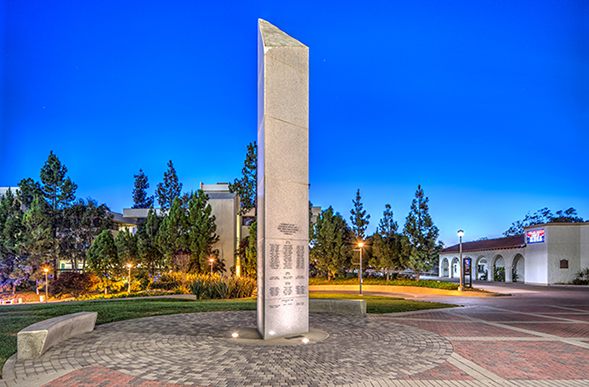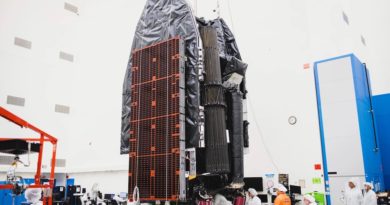Daily Business Report-Dec. 2, 2019
War Memorial on Aztec Green (Photo: Jim Brady)
Support for veterans is part of
San Diego State University’s identify
San Diego State NewsCenter
Each year during Homecoming Week, San Diego State University hosts a commemoration ceremony at the campus War Memorial to honor veteran alumni who have died in service during the nation’s military conflicts.
The ceremony consists of reflections about the monument and the sacrifices it represents, laying of wreaths by those who wish to contribute, and a reading of each name etched in the monument by members of the Student Veteran Organization.
The War Memorial, a 25-foot-high Sierra White granite monolith, displays the names of 239 Aztecs who lost their lives in World War II, the Korean and Vietnam wars and the conflicts in Iraq and Afghanistan.
It was designed by SDSU art professor emeritus Jesus Dominguez with a jagged top to represent lives cut short by war. It was funded by SDSU Alumni’s War Memorial Committee and dedicated Nov. 23, 1996.
Only a small number of U.S. universities have a war memorial as prominent and a student-veteran population as large as SDSU’s.
But the War Memorial and ceremony are only pieces of the university’s deeper commitment to supporting student veterans.
History
At the beginning of World War II, San Diego State College geography professor Lauren Post made a promise to the young Aztecs leaving for military service that the campus community would not forget them.
For 48 months, he and a group of volunteers published letters from the soldiers—along with news from back home—in a magazine-style broadsheet with the simple name, the Aztec News Letter. The volunteers collected donations to sustain the publication and mail it to every combat theater where Aztecs were stationed.
Today these letters are part of the World War II Servicemen’s Correspondence Collection in SDSU’s Special Collections and University Archives.
Established in the 1920s as a repair base, Naval Base San Diego expanded quickly during World War II. As the nearest campus to the base, San Diego State Teachers College became a center of military activity. Just days after the Japanese bombed Pearl Harbor on Dec. 7, 1941, the government stationed military personnel on campus. They left in early 1942, as the threat of another attack faded, but reminders of the war were everywhere.
In 2008, SDSU became the first in the California State University system to open a Veterans Center. Three years later, it was named the Joan and Art Barron Veterans Center after the couple whose $1 million gift endowed it. The 4,000-square-foot space is a full-service center for SDSU’s military-connected students.
Ongoing commitment
More than seven decades later, SDSU continues to be a campus of choice for military students, veterans and their dependents. SDSU currently serves more than 4,100 military-affiliated students, including veterans, active duty reservists and dependents.
Earlier this year, SDSU became the first public university on the West Coast to have an interdisciplinary program in modern U.S. military history. Announced June 11 during a presentation aboard the USS Midway, the USS Midway Foundation made a $3 million, five-year pledge to create and fund an endowed chair in modern U.S. military history at SDSU.
A popular program for veterans, Troops to Engineers, transitions military men and women into engineering careers. The university also boasts a Military Ally Awareness Program, which explores the unique characteristics of the military and veteran community, and the Women Veterans Success Program, established in 2016, to assist female veterans with personal growth and professional development.
Throughout the years, SDSU continues to honor and provide a home for those who serve in our nation’s military as well as recognizing the contributions of all those connected with the military and veteran community.
______________________
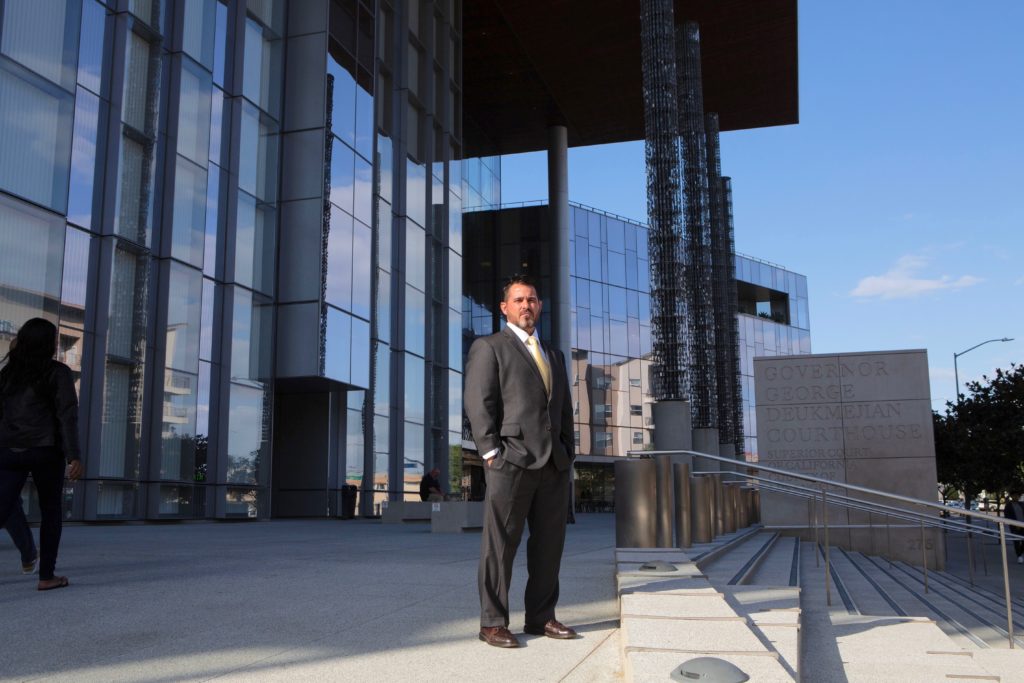
California is about to allow former
felons to serve on juries. Here’s why
By Elizabeth Castillo | CalMatters
James Binnall s no stranger to the courtroom. He worked as a defense lawyer in San Diego on several homicide cases. Then he was summoned for jury duty at the same courthouse, and arriving via a special entrance designated for attorneys, began filling out his juror questionnaire.Question #7 asked if he had ever been convicted of a felony. He checked “yes.”
Binnall had served prison time after a homicide conviction for driving drunk as a 23-year-old graduate student in 1999, crashing his car and killing his friend and passenger. While on parole, he went to Thomas Jefferson School of Law, graduating and maxing-out his seven-year sentence the same week. But he learned the day of his jury summons in 2009 that California prohibits former felons for life from serving on juries.
“When I finally became an attorney, I sort of felt like I had gotten over the hump. That I was back to being a full-fledged citizen,” Binnall said. “Walking home, it was, am I ever going to be able to transcend this criminal background that I have? It’s followed me since it happened and I’ve worked and worked and worked to put it behind me, and this is now a perpetual reminder.”
On Jan. 1, the rules will change. A new law by Berkeley Democratic Sen. Nancy Skinner will allow Californians with most former felony convictions who are no longer on parole or probation to serve on juries.
Advocates say the law brings California one step closer to solving racial disparities that exist in the jury selection process: One in five African-American men in California is barred from jury service because of a prior felony, according to 2017research. And that complicates efforts to ensure every defendant a jury of his or her peers.The opponents say former criminals should not be allowed to serve on juries because they are much more likely to be biased against police and prosecutors.
______________________
New Agricultural Water Program
benefits San Diego County growers
The San Diego County Water Authority’s Board of Directors has approved a new and permanent Special Agricultural Water Rate structure that offers lower water rates to farmers in exchange for lower water supply reliability.
Unlike the current temporary program, the new program will let new participants join as a way to strengthen the region’s multi-billion-dollar agriculture industry.
New ag water program rates will be determined in the spring of 2020 as part of the Water Authority’s annual rate-setting process. The program will take effect Jan. 1, 2021, replacing the current program that sunsets at the end of 2020. Additional program details, such as the signup process and qualifying criteria, also will be developed early next year.
Farmers and growers who participate in the new program will continue to receive a lower level of water service during water shortages or emergencies, allowing the Water Authority to reallocate those supplies to commercial and industrial customers, who pay for full reliability benefits. In exchange, participating farmers are exempt from fixed water storage and supply reliability charges. Under the current temporary program in 2020, participants will pay $1,231 per acre-foot for treated water, while municipal and industrial users will pay $1,686 per acre-foot.
Leane Marchese is the new executive director of the Beach and Bay Family YMCA.
______________________
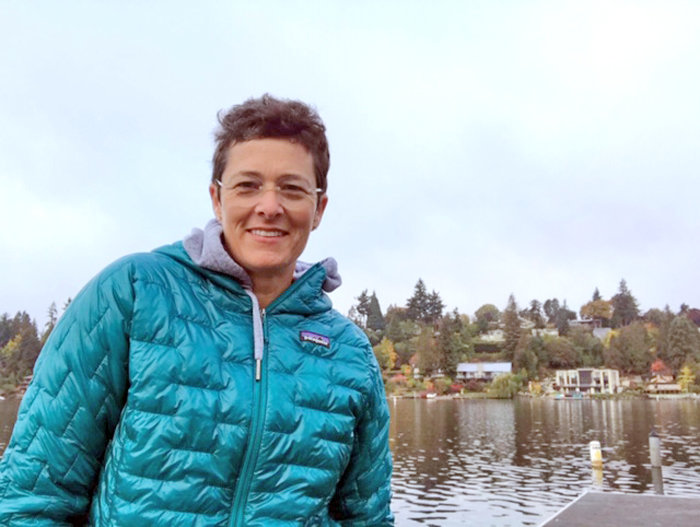
New executive director to lead
Beach and Bay Family YMCA
By Dave Schwab | sdnews.com
Beach and Bay Family YMCA in Pacific Beach has a new executive director, Leane Marchese, who has a lifelong commitment to improving recreational quality for all.
Previously having served as regional associate executive director for five years at the Mission Valley YMCA, Marchese was chosen for her new role after an extensive search. She has effectively served as the interim executive director at the PB branch at 4606 Ingraham St. at the corner of Felspar, for the past six months.
“Leane is a tremendous asset to the Y and to our community-at-large,” said Lisa D’Angelo, area vice president for the YMCA of San Diego County.
“The Y’s vision is to expand its presence in San Diego’s beach and bay communities by building a state-of-the-art YMCA fitness center in Pacific Beach. With Leane’s leadership and operational experience, we are looking forward to bringing this vision to life.”
Marchese’s hire comes at a propitious time. Two years ago, the Pacific Beach YMCA celebrated the first phase of a shared venture with San Diego Unified School District. It hosted a ribbon-tying to debut its new joint-occupancy turf field surrounded by a track. The new field is striped for multiple sports including soccer, field hockey, and girls and boys lacrosse.
That was followed a year later by the construction of two state-of-the-art padel tennis courts behind the YMCA’s outdoor fitness facility. A community pool is planned in the future.
Read more…
______________________
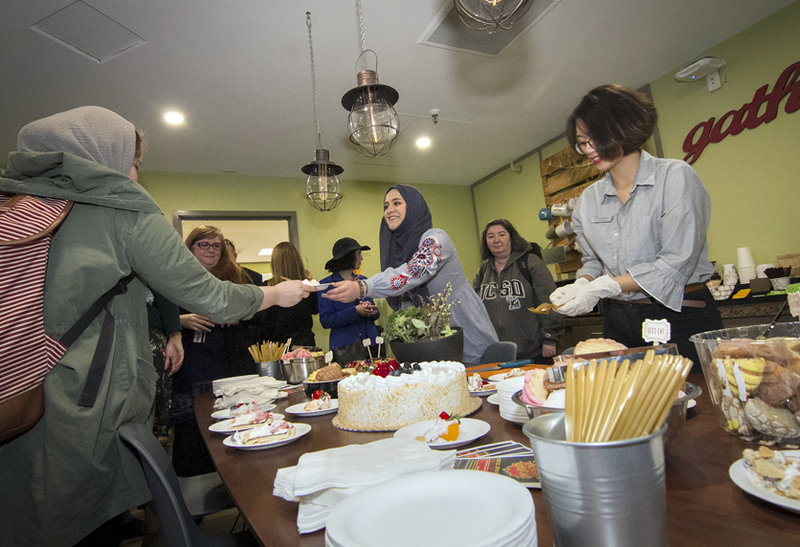
Keeping students healthy with mobile
food pantries at UC San Diego
By Leorah Gavidor | sdnews.com
A new resource is available for UC San Diego students: mobile food pantries. Setting up once a week in various “neighborhoods” around campus, the vans are stocked with a free selection of produce and non-perishables from the main Triton Food Pantry.
Though the main pantry is open every day, it can be difficult for students to cross the sprawling campus to get there. Pop-up pantries provide convenient access to fresh, healthy food near dorms or classes, said basic needs coordinator Alicia Magallanes.
One-quarter of college students experience food insecurity each week, and 36% were housing insecure last year. During Hunger and Homelessness Awareness Week in November, several events highlighted resources available at UC San Diego.
Attracted by the delicious smell and the iconic white hat, more than 80 students lined up for chef Vaughn Vargas’s pad Thai interactive cooking demonstrations, complete with hot wok. He showed students how to cook noodles and upgrade the meal’s nutritional value with budget-friendly stir-fry veggies.
“The food pantry gets organic produce donated from Leucadia Farmers Market,” said Magallanes, “it’s beautiful.” Fruits and vegetables also come from the student-led Food Recovery Network, UC San Diego’s local chapter of a national student movement, which collects food that would otherwise go to waste. Since 2016, the group has hauled more than 36,000 pounds. A local Vons, San Diego Food Bank, campus dining halls, and other grocery stores also contribute to Triton Food Pantry.
Read more…
______________________
One-two punch drug combo offers
hope for pancreatic cancer therapy
Scientists at Sanford Burnham Prebys Medical Discovery Institute have identified a combination of two anti-cancer compounds that shrank pancreatic tumors in mice—supporting the immediate evaluation of the drugs in a clinical trial. U.S. Food and Drug Administration (FDA)–approved versions of the compounds are used today to treat certain leukemias and solid tumors, including melanoma. The study was published in Nature Cell Biology.
______________________
Kratos’ XQ-58A awarded Aviation Week’s Laureate
Award for Defense Technology & Innovation
San Diego-based Kratos Defense & Security Solutions Inc. announced dthat its XQ-58A Valkyrie has been awarded the Aviation Week Network’s Laureate Award for Technology & Innovation in the Defense Sector.
Kratos’ XQ-58A Valkyrie is a tactical/strike unmanned aerial vehicle developed in partnership with the Air Force Research Laboratory and managed within AFRL’s Low Cost Attritable Aircraft Technology portfolio. The XQ-58A was designed to accomplish myriad tasks in high-threat environments while being a cost-effective force multiplier to the warfighter.

